FINAL HOURS: Lock in your InvestingPro subscription for 50% off before sale ends
Executive Summary
Maple Leaf Foods Inc . (TSX:MFI) reported strong first-quarter 2025 results, with accelerated revenue growth of 8.2% and a 43% jump in Adjusted EBITDA to $166 million. The company’s EBITDA margin expanded by 330 basis points to 13.4%, driven by improved performance across all business segments. Management reiterated its 2025 guidance of Adjusted EBITDA of $634 million or greater and confirmed that the planned spin-off of its Canada Packers pork business remains on track for the second half of 2025.
The company also announced a 9% increase in its quarterly dividend to $0.24 per share, marking its 10th consecutive annual dividend increase, while maintaining its leverage ratio within investment-grade range at 2.6x Net Debt to LTM Adjusted EBITDA, an improvement of 1.1x compared to a year ago.
Quarterly Performance Highlights
Maple Leaf Foods delivered solid financial results in the first quarter of 2025, with sales reaching $1.24 billion, up 8.2% from $1.15 billion in Q1 2024. Adjusted EBITDA grew significantly to $166.3 million, a 42.9% increase from $116.4 million in the same period last year.
As shown in the following chart highlighting Q1 2025 key financial metrics:
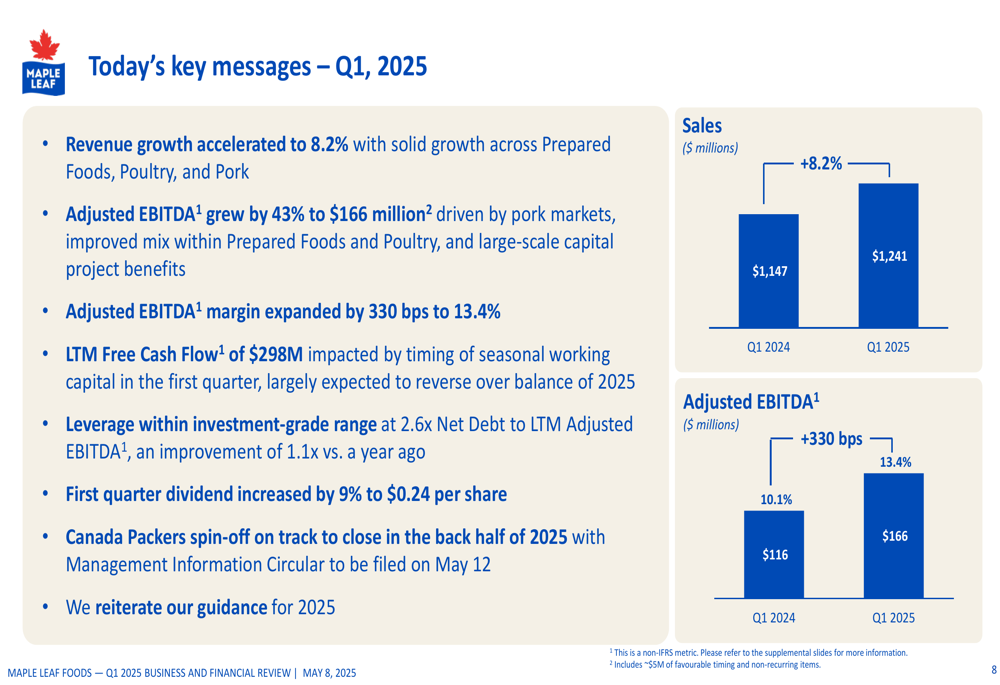
Adjusted Operating Earnings saw an even more dramatic improvement, increasing 80.8% to $95.7 million compared to $53.0 million in Q1 2024. The company’s Adjusted EBITDA margin expanded by 330 basis points to 13.4%, reflecting improved operational efficiency and more favorable market conditions.
Free Cash Flow for the quarter was negative at $(13.6) million, compared to positive $73.6 million in Q1 2024, which the company attributed to timing of seasonal working capital that is largely expected to reverse over the balance of 2025.
The company’s balance sheet continued to strengthen, with total long-term debt decreasing by $256 million year-over-year to $1.67 billion. Net Debt declined by $169 million to $1.55 billion, resulting in a Net Debt to LTM Adjusted EBITDA ratio of 2.6x, down from 3.7x a year earlier.
Segment Performance
Maple Leaf Foods reported strong performance across all three of its business segments in Q1 2025:
Prepared Foods, which accounts for approximately 55% of annual sales, delivered sales growth of 7.1% driven by volume growth, improved mix, and pricing. The company noted continued double-digit sales growth in Sustainable Meats and in the U.S. market, while also benefiting from its Bacon Centre of Excellence investment.
Poultry, representing about 20% of annual sales, achieved sales growth of 6.0%, attributed to improved mix driven by retail growth and a reduction in lower-margin industrial sales. The company is harvesting benefits from its London Poultry investment, though sustainable poultry sales were only marginally up due to the current consumer environment.
The Pork Complex (Canada Packers), which makes up roughly 25% of annual sales, posted the strongest growth with sales increasing by 12.0%. This was driven by an increased number of hogs processed (up 6%), higher average hog weights, positive foreign exchange impacts, and higher market pricing. Vertically integrated spreads improved due to lower feed costs, while packer spreads contracted.
The following image illustrates the company’s operational highlights across these segments:

Strategic Initiatives
A key strategic focus for Maple Leaf Foods is the planned spin-off of its Canada Packers pork business, which remains on track to close in the second half of 2025. The company plans to file its Management Information Circular on May 12, 2025.
As detailed in the following slide, the spin-off is designed to unlock shareholder value by creating two independent public companies with sharper focus on their respective growth strategies:
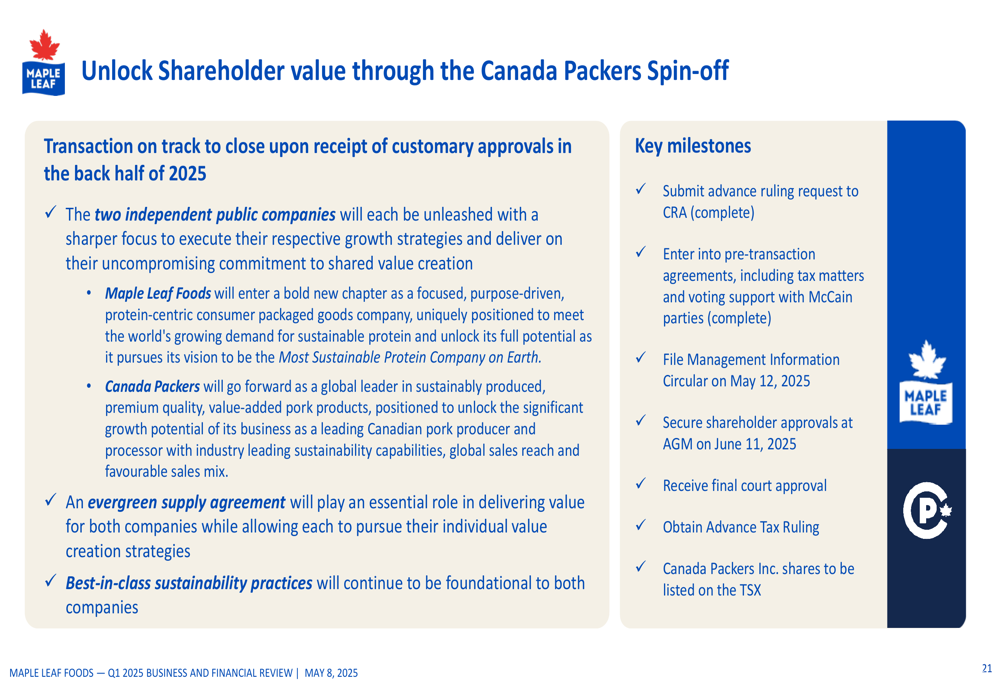
Post-spin-off, Maple Leaf Foods will operate as a focused, purpose-driven, protein-centric consumer packaged goods company, while Canada Packers will function as a global leader in sustainably produced, premium quality, value-added pork products. The companies will maintain an evergreen supply agreement, and sustainability practices will remain foundational to both entities.
The company also highlighted its strong portfolio of leading brands, which includes the #1 Schneiders and #2 Maple Leaf brands in Packaged Meats, the #1 Greenfield brand in Sustainable Packaged Meats, the #1 Maple Leaf Prime brand in fresh poultry, and the #1 Mina Halal brand in fresh poultry.
As shown in the following brand portfolio overview:
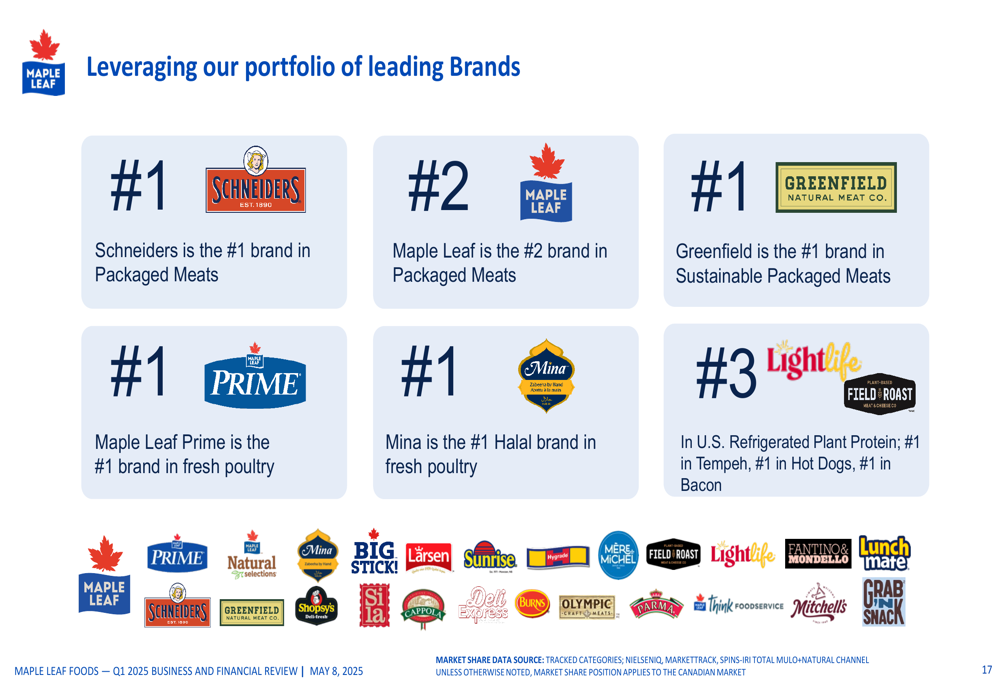
In the U.S. market, Maple Leaf Foods holds the #3 position in Refrigerated Plant Protein, with #1 positions in Tempeh, Hot Dogs, and Bacon categories.
Outlook and Guidance
Maple Leaf Foods reiterated its 2025 guidance, targeting Adjusted EBITDA of $634 million or greater. The company plans to achieve this through several key strategies, including driving mid-single-digit revenue growth, harvesting benefits from large capital projects, improving brand and revenue management, and executing "Fuel for Growth" initiatives.
The following slide outlines the company’s 2025 guidance and strategic initiatives:
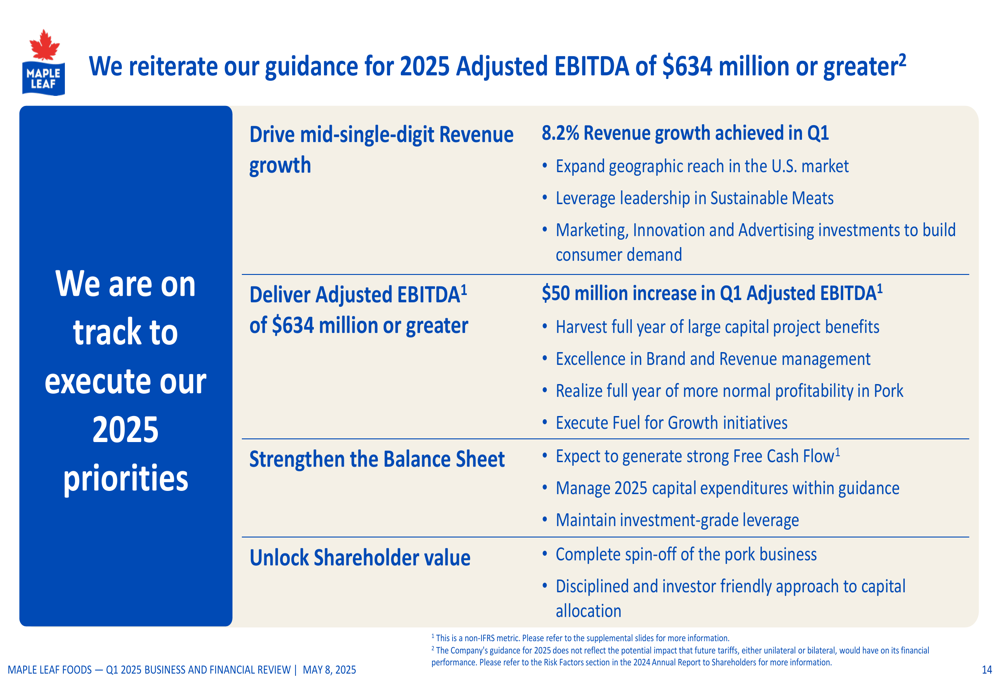
For 2025, Maple Leaf Foods expects to generate strong free cash flow and manage capital expenditures within the guidance range of $175-$200 million, while maintaining investment-grade leverage.
The company also emphasized its investor-friendly capital allocation priorities, highlighting its 10th consecutive annual dividend increase. Dividends per share have grown from $0.32 in 2015 to an expected $0.96 in 2025, representing an 11.6% CAGR over this period.
As illustrated in the following capital allocation priorities slide:
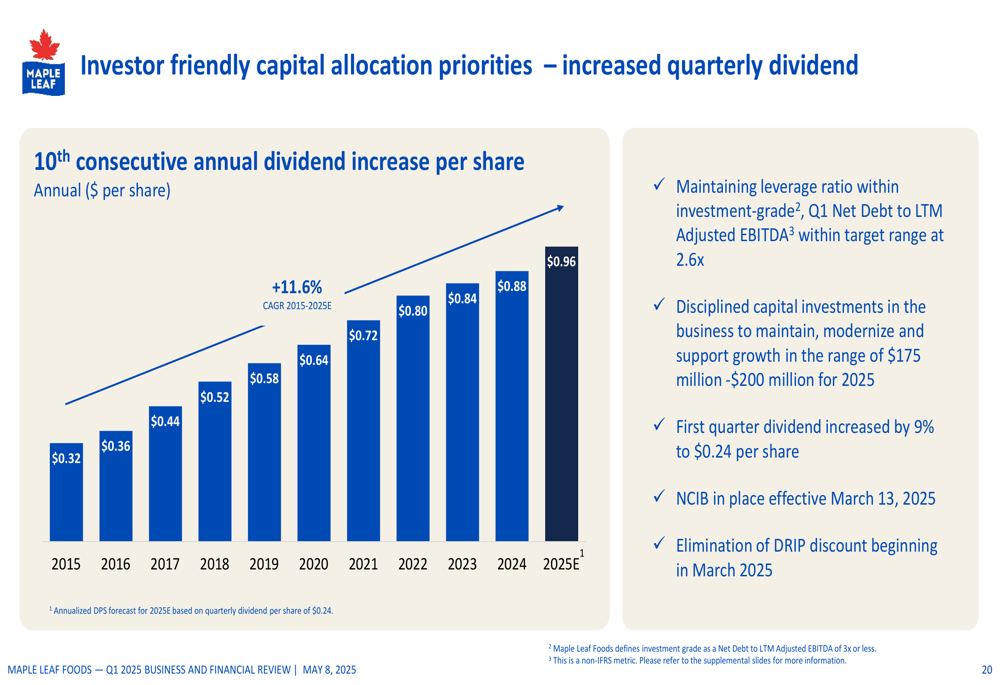
Additional investor-friendly measures include maintaining leverage within investment-grade range, disciplined capital investments, and the implementation of a Normal Course Issuer Bid (NCIB) effective March 13, 2025, along with the elimination of the Dividend Reinvestment Plan (DRIP) discount beginning in March 2025.
Long-Term Fundamentals
Maple Leaf Foods has demonstrated consistent improvement in its long-term fundamentals, with a 4.4% CAGR in revenue from 2019 to 2024. The company’s profitability has significantly improved, with Adjusted EBITDA growing from $273 million (5.8% margin) in 2022 to $603 million (12.0% margin) for the twelve months ended Q1 2025.
The following chart illustrates these improving long-term fundamentals:
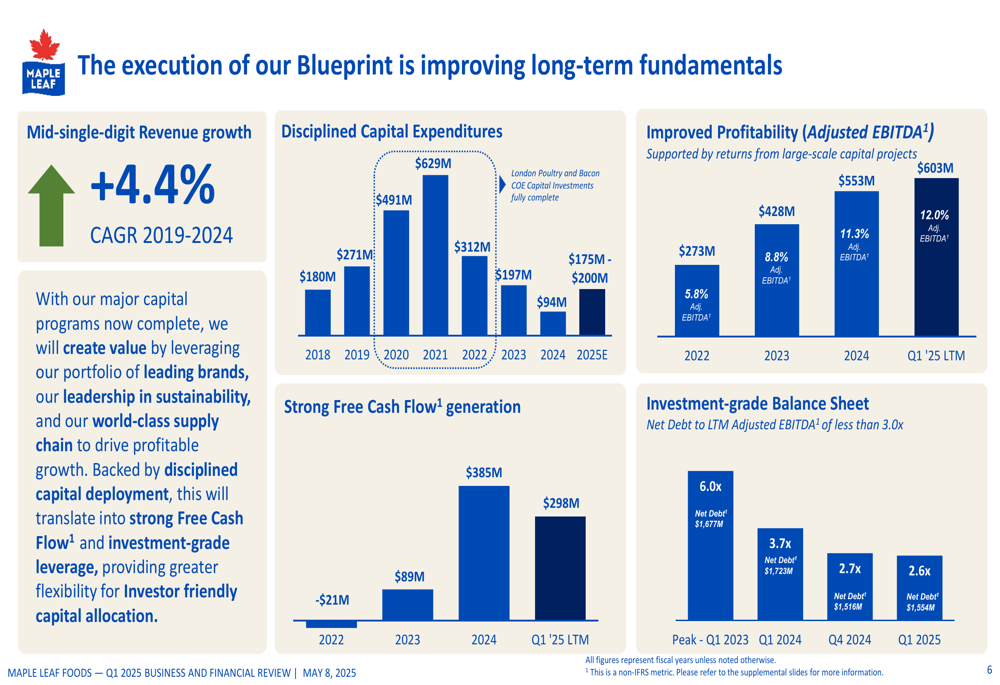
Free Cash Flow has also shown strong improvement, increasing from negative $21 million in 2022 to $298 million for the twelve months ended Q1 2025. Similarly, the company’s balance sheet has strengthened considerably, with Net Debt to LTM Adjusted EBITDA improving from 6.0x in 2022 to 2.6x in Q1 2025.
These improvements reflect the company’s successful execution of its strategic initiatives, including the completion of major capital projects and operational efficiency improvements, positioning Maple Leaf Foods for sustained growth and value creation.
Full presentation:
This article was generated with the support of AI and reviewed by an editor. For more information see our T&C.
